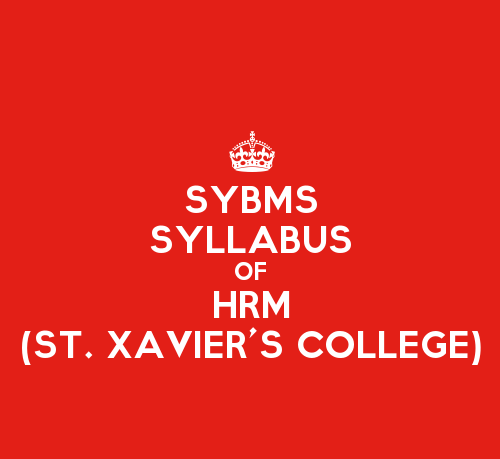Human Resource Management is a Sem 3 subject in SYBMS at St. Xavier’s College. The subject aims to make students understand human resource in its proper perspective. Human Resource Management (HRM) subject aims to familiarize the students with the various functions of human resource management and lay a strong foundation for pursuing goals of becoming HR strategists, change agents and organizational transformationalists.
There are 4 main units covered in Human Resource Management subject which are as follows:
- Unit 1 – Introduction to HRM and Human Resource Planning – 8 plus 6 lectures
- Unit 2 – Job analysis, Job Design and Job evaluation – 5 lectures
- Recruitment, selection and Induction – 5 lectures
- Training and Development – 6 lectures
- Unit 3 – Performance Appraisal – 7 lectures
- Compensation management – 6 lectures
- Career planning and development – 6 lectures
- Unit 4 – Participative Management – 4 lectures
- Industrial relations – 4 lectures
- Trade Unions – 3 lectures
The topics covered in Unit 1 are as follows:
In Introduction to HRM, the topics covered are:
- Definition, features, scope / functions of HRM,
- Evolution of HRM / trends in HRM
- Differences between HRM and PM
- Challenges before the HR Manager
- Role of the HR Manager
- Traits / characteristics of the workforce, personnel philosophy,
- Personnel Manual
In the Human Resource Planning section,
- Definition of HRP
- Process of HRP alongwith brief coverage of personnel demand and supply
- Forecasting techniques
- Factors affecting HRP
- HRIS
- VRS, Outsourcing, pink slip / termination / retrenchment / downsizing / separation
- Contracting and sub-contracting
- Promotions and transfers.
In the Unit 2, Job analysis, Job Design and Job Evaluation section includes:
- Job analysis – definition, method of collecting job data, merits and demerits / limitations
- Job design definition, factors affecting job design, approaches to job design,
- Job evaluation – definition, methods of job evaluation, process of job evaluation.
In Unit 2, Recruitment, selection and Induction section includes:
- Recruitment – Definition, sources of recruitment, merits and demerits,
- Selection – definition, process of selection, types of selection tests, types of interviews
- Induction / orientation – definition, methods, process
- Placement
In Unit 2, Training and Development section includes:
- Definition of training and development
- Methods of training Managers
- Process / procedure of conducting training programs
- How to evaluate effectiveness of training program
- Advantages of T & D
In Unit 3, Performance appraisal section includes:
- Definition,
- Methods of appraisal for managers – traditional and modern,
- Process / procedure of conducting performance appraisal,,
- Advantages of performance appraisal,
- Limitations of performance appraisal.
In Unit 3, Compensation management section includes:
- Definition of compensation,
- Components of salary / salary slip,
- Fringe benefits – definition and types,
- Performance linked incentives / incentives definition, advantages and disadvantages.
In Unit 3, Career planning and Development section includes:
- Definition of career planning and career development,
- Process/ procedure
- Career stages / career life cycle and how to handle personnel at each stage
- Essentials to make career planning successful
- Career counseling
- Employee Retention techniques
- Succession planning
In Unit 4, Participative Management section includes:
- Definition of participative management
- Levels of participation
- Trends in participative management
- Factors important for effective participative management
- Forms of participation
- Participation through quality circles
- Empowered teams
In Unit 4, Industrial relations section includes:
- Definition of industrial relations
- Features of industrial relations
- Importance of industrial relations
- Approaches to industrial relations
- Parties to industrial relations
In Unit 4, Trade Unions section includes:
- Definition of a trade union
- Features of a trade union
- Trade Union movement in India
- Trends in Trade Unions
Continuous Internal Assessment:
- Mid Semester Test
- Project work –presentations
The list of reference books for Human Resource Management are as follows:
- Human Resources and Personnel Management – K. Aswathappa, Test and Cases, 4e
- Personnel Management – Mamoria
- Personnel management – Flippo, Mcgraw
- Excellence through HRD – M. Nair and T.V. Rao
- Handbook of Human Resource Management practice – Armstrong and Micheal Kogan Page



119 Comments